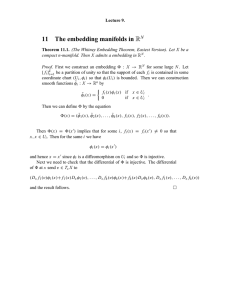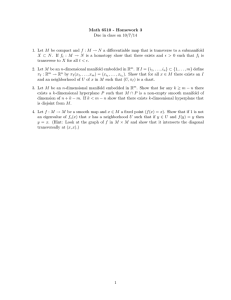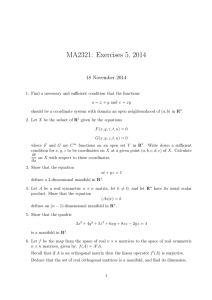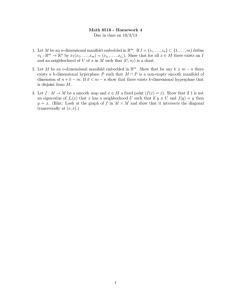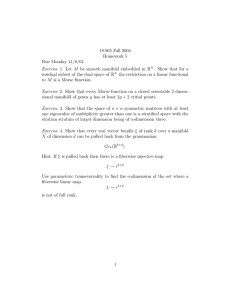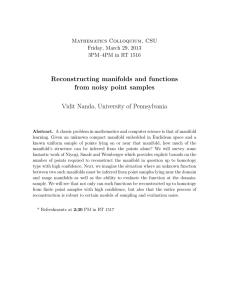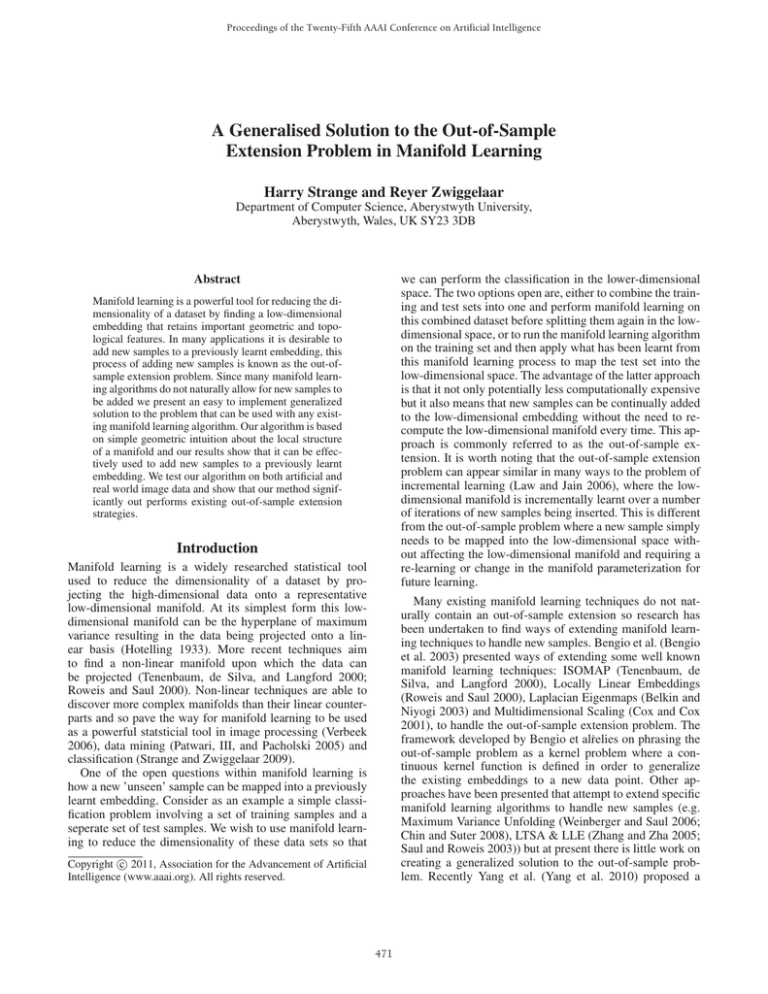
Proceedings of the Twenty-Fifth AAAI Conference on Artificial Intelligence
A Generalised Solution to the Out-of-Sample
Extension Problem in Manifold Learning
Harry Strange and Reyer Zwiggelaar
Department of Computer Science, Aberystwyth University,
Aberystwyth, Wales, UK SY23 3DB
we can perform the classification in the lower-dimensional
space. The two options open are, either to combine the training and test sets into one and perform manifold learning on
this combined dataset before splitting them again in the lowdimensional space, or to run the manifold learning algorithm
on the training set and then apply what has been learnt from
this manifold learning process to map the test set into the
low-dimensional space. The advantage of the latter approach
is that it not only potentially less computationally expensive
but it also means that new samples can be continually added
to the low-dimensional embedding without the need to recompute the low-dimensional manifold every time. This approach is commonly referred to as the out-of-sample extension. It is worth noting that the out-of-sample extension
problem can appear similar in many ways to the problem of
incremental learning (Law and Jain 2006), where the lowdimensional manifold is incrementally learnt over a number
of iterations of new samples being inserted. This is different
from the out-of-sample problem where a new sample simply
needs to be mapped into the low-dimensional space without affecting the low-dimensional manifold and requiring a
re-learning or change in the manifold parameterization for
future learning.
Abstract
Manifold learning is a powerful tool for reducing the dimensionality of a dataset by finding a low-dimensional
embedding that retains important geometric and topological features. In many applications it is desirable to
add new samples to a previously learnt embedding, this
process of adding new samples is known as the out-ofsample extension problem. Since many manifold learning algorithms do not naturally allow for new samples to
be added we present an easy to implement generalized
solution to the problem that can be used with any existing manifold learning algorithm. Our algorithm is based
on simple geometric intuition about the local structure
of a manifold and our results show that it can be effectively used to add new samples to a previously learnt
embedding. We test our algorithm on both artificial and
real world image data and show that our method significantly out performs existing out-of-sample extension
strategies.
Introduction
Manifold learning is a widely researched statistical tool
used to reduce the dimensionality of a dataset by projecting the high-dimensional data onto a representative
low-dimensional manifold. At its simplest form this lowdimensional manifold can be the hyperplane of maximum
variance resulting in the data being projected onto a linear basis (Hotelling 1933). More recent techniques aim
to find a non-linear manifold upon which the data can
be projected (Tenenbaum, de Silva, and Langford 2000;
Roweis and Saul 2000). Non-linear techniques are able to
discover more complex manifolds than their linear counterparts and so pave the way for manifold learning to be used
as a powerful statsticial tool in image processing (Verbeek
2006), data mining (Patwari, III, and Pacholski 2005) and
classification (Strange and Zwiggelaar 2009).
One of the open questions within manifold learning is
how a new ’unseen’ sample can be mapped into a previously
learnt embedding. Consider as an example a simple classification problem involving a set of training samples and a
seperate set of test samples. We wish to use manifold learning to reduce the dimensionality of these data sets so that
Many existing manifold learning techniques do not naturally contain an out-of-sample extension so research has
been undertaken to find ways of extending manifold learning techniques to handle new samples. Bengio et al. (Bengio
et al. 2003) presented ways of extending some well known
manifold learning techniques: ISOMAP (Tenenbaum, de
Silva, and Langford 2000), Locally Linear Embeddings
(Roweis and Saul 2000), Laplacian Eigenmaps (Belkin and
Niyogi 2003) and Multidimensional Scaling (Cox and Cox
2001), to handle the out-of-sample extension problem. The
framework developed by Bengio et alṙelies on phrasing the
out-of-sample problem as a kernel problem where a continuous kernel function is defined in order to generalize
the existing embeddings to a new data point. Other approaches have been presented that attempt to extend specific
manifold learning algorithms to handle new samples (e.g.
Maximum Variance Unfolding (Weinberger and Saul 2006;
Chin and Suter 2008), LTSA & LLE (Zhang and Zha 2005;
Saul and Roweis 2003)) but at present there is little work on
creating a generalized solution to the out-of-sample problem. Recently Yang et al. (Yang et al. 2010) proposed a
c 2011, Association for the Advancement of Artificial
Copyright Intelligence (www.aaai.org). All rights reserved.
471
Y = f (X)
(1)
Unless we are dealing with a linear manifold learning algorithm such as Principal Components Analysis this function will be difficult to learn at a global scale. Instead we
can think of Y as being built up by individual functions for
each sample. That is for the i-th datapoint yi = fi (xi ). The
out-of-sample problem can thus be thought of as finding a
function that best approximates the transformation undergone via manifold learning, that is for an unlearnt sample
min(||ϕ − ϕ ||) where ϕ is the actual embedding of the sample and ϕ is its estimated embedding. This problem is evidently cyclical as we need the actual embedding to be able
to find the function to minimize but we need to minimize the
function to find the actual embedding.
To solve this problem it is helpful to take a step back
and consider the situation where we know the actual lowdimensional representation, y, of a sample x. To re-create
the embedding of x we can examine the local geometric
structure around x in the high and low-dimensional spaces.
If we assume that the result of running a manifold learning
algorithm is a local change in the neighboring geometry of a
sample then we can reformulate the problem as that of finding a simple linear transformation
Figure 1: The new sample is attached to its nearest neighborhood in the high-dimensional space and then projected
onto the low-dimensional hyperplane defined by the principal components of that neighborhood.
method for a generalized out-of-sample method based on
their manifold learning technique Local and Global Regressive Mapping. Regularization is used to learn a model to allow out-of-sample extrapolation and as such they claim that
their framework can be applied to any manifold learning algorithm to enable an out-of-sample extension.
In this paper we present a generalized out-of-sample extension (GOoSE) solution. Unlike existing approaches we
do not require information to be retained from the learning
process, such as the pairwise distance matrix or the resultant
eigenvectors, we simply learn the mapping from the original
high-dimensional data and its low-dimensional counterpart.
As such our method is independent of any specific manifold
learning algorithm. The change in local geometry between
the high and low-dimensional spaces provides the information needed to compute the transformation of new samples
into the low-dimensional space. This simplicity means that
our approach can be used to extend any manifold learning
technique to handle the out-of-sample extension problem.
The rest of this paper is structured as follows. We begin
by outlining the algorithm behind our generalized solution
before moving on to show how this generalized solution performs on artificial and real world data. In the Results section
we show how using GOoSE can produce comparable results
to the existing out-of-sample techniques described above.
We end by presenting conclusions and possible directions
for future work.
y = AVx
(2)
where A is a similarity transformation matrix and V is a
matrix that projects x into the low-dimensional space. We
now seek to find A and V that best approximates the local
transformation. Given that we know the target dimensionality, q, and we take the manifold to be locally linear we can
find the projection matrix V by performing Principal Components Analysis on a local neighborhood of the k-nearest
samples according to Euclidean distance around x. We denote the samples in this neighborhood as XNi and so the
principal components are found by
ΛV = CV
(3)
where C is the covariance matrix of XNi and V is a matrix
containing as columns the top q-dimensional eigenvectors
sorted according to their associated eigenvalues, Λ. We can
now find the low-dimensional representation of x by projecting onto the eigenvectors, y = Vx (Figure 1).
Algorithm
The basic premise of our algorithm is to find the transformation that maps a new unseen sample’s neighborhood from
the high-dimensional to the low-dimensional spaces. This
transformation is equivalent, as far as possible, to running
the manifold learning technique on the given sample.
Given the original data set X = {xi }ni=1 ∈ Rp and its
low-dimensional representation Y = {yi }ni=1 ∈ Rq , where
q p, we wish to find the low-dimensional approximation,
ϕ ∈ Rq , of an unkown sample, φ ∈ Rp , given that φ X.
We assume that X is sampled from a hidden manifold M,
that is X ⊆ M, and also that at a local scale M is linear (i.e.
M is a C ∞ manifold). Since Y is the result of manifold
learning we can describe Y in terms of a function on X.
That is
Figure 2: Since we assume that the transformation undergone as a result of manifold learning can be approximated
as a local linear transform we aim to find that transform. By
applying that transform to the new sample we can find its
approximate low-dimensional image.
472
To find the similarity transformation matrix we need
to examine the change in local geometry. We first need
to project the local neighborhood XNi into the lowerdimensional space by projecting onto the eigenvectors V
(3). We represent this low dimensional projected neighborhood as Y and the same neighborhood of points in the lowdimensional embedding as Y. For convenience we drop the
subscripted Ni so when referring to Y we actually mean
YNi and similary Y is Y Ni .
We know that
Y ≈ AY
This process is described in algorithmic form in Algorithm 1.
Algorithm 1 Generalized Out-of-Sample Extension
Require: x ∈ RD , X ∈ RD , Y ∈ Rd , k |X|
1: idx ← nn(x, X, Y, k)
2: ΛV = CX V
3: Z = Xidx V1...d
4: (UΣV) ← svd(Z Yidx )
5: B ← eye(d, d)
range(Y1 )
range(Yd )
6: diag(B) = [ range(Z1idx) . . . range(Zdidx) ]
idx
idx
7: T ← UVT
8: y ← xV1...d
9: y ← ByT
10: return y
(4)
and that the transformation matrix A can be represented in
terms of a seperate scale and rotation component
Y ≈ BRY
(5)
where B is a non-isomporphic scale matrix and R is the
rotation matrix. The task now becomes to find the scale and
rotation that transforms Y to Y (Figure 2).
To find the solution to this problem we use a method from
statistical shape theory and find the singular value decompoT
sition (SVD) of the matrix Y Y.
To find the rotation matrix R and the scale value b we
first find the singular value decomposition
YT Y = UΣVT
Discussion & Results
In this section we provide both visual and quanititative evaluation of our method. We begin by defining an embedding
error which can be used to analyse the performance of an
out-of-sample extension algorithm.We then move on to discuss how GOoSE’s only parameter, k, affects the accuracy
of the estimated low-dimensional embedding before finally
displaying results using both artificial data as well as real
world image data.
(6)
the rotation matrix can then be found by
R = UVT
Embedding Error
(7)
To be able to analyse the performance of out-of-sample extensions we need to first define an embedding error. Given
a dataset D we create a training set, B, and test set, C,
such that B ∪ C = D, B ∩ C = ∅ and |B| = |D| −
|C|. As in (Yang et al. 2010) we can obtain the lowdimensional embedding, Y, by running a manifold learning
algorithm on the entire dataset D. We can then express Y as
Y = [Ytrain , Ytest ]T where Ytrain and Ytest are the lowdimensional embeddings of the training and test data. Once
Y is know we can use B to obtain the training set of the
manifold and then use an out-of-sample extension method
to estimate the low-dimensional embedding of C. We denote the estimated low-dimensional embedding of the test
, we can now define an embedding error based on
data Ytest
the root mean square error between the actual and estimated
test sets
)2
(Ytest − Ytest
(10)
e=
n
where n is the number of elements in the test set and both
are transformed according to the rotational
Ytest and Ytest
difference between Ytrain and B to remove the effect of
the manifold learning algorithms mapping the datasets into
different low-dimensional spaces1 . This error measure now
Once the rotation has been applied we find the scale matrix by
⎡
⎢
B=⎢
⎣
max(Y 1 )−min(Y 1 )
max(Y 1 )−min(Y 1 )
..
.
...
...
..
.
...
...
..
.
max(Y q )−min(Y q )
max(Y q )−min(Y q )
⎤
⎥
⎥
⎦
(8)
where Y1 indicates the column vector containing all samples along the first dimension of Y and Yq indicates the
column vector containing all samples along the q th dimension.
Now we return to the original problem of finding the
low-dimensional representation, ϕ, of an unlearnt sample
φ. As we have shown above, an approximation of the lowdimensional embedding of a neighborhood in the highdimensional space can be found. So a simple solution to
finding the low-dimensional representation of an unlearnt
sample is to find the rotation and scale transformations of the
sample’s nearest neighbors and then applying these transforms to the unlearnt samples. This can be done by finding the k-nearest neighbors of φ in X, XNφ . We then find
the projection matrix of XNφ according to (3) and the rotation and scale values according to (7) and (8). The lowdimensional representation, ϕ, of φ then becomes
ϕ = BRVNφ φ
1
This is something that is not considered by Yang et al. in (Yang
et al. 2010) but without this step the results obtained are meaningless as the two low-dimensional embeddings are in different coordinate spaces
(9)
473
−3
2
Results
x 10
To test our algorithm we use 3 main datasets: a 3dimensional Swiss Roll, a moving image dataset and the
ISOMAP faces data. Each of these datasets presents a different challenge for a manifold learning algorithm and subsequently an out-of-sample extension algorithm.
1.8
1.6
RMSE
1.4
Swiss Roll The Swiss Roll dataset consists of a 2dimensional manifold embedded within R3 . This 2dimensional manifold is a highly-curved plane that is rolled
up to resemble a Swiss Roll (Figure 4). A manifold learning
algorithm should be able to ’unwrap’ this Swiss Roll and
embed it into R2 . We used 2000 points sampled from the
Swiss Roll and this was randomly split into 1000 samples
for training and 1000 samples for test. We used four different manifold learning algorithms (LLE (Roweis and Saul
2000), LTSA (Zhang and Zha 2005), Eigenmaps (Belkin
and Niyogi 2003) and LGRM (Yang et al. 2010)) to learn
the low-dimensional training embedding before applying
GOoSE to estimate the test set’s low-dimensional embedding. These algorithms were chosen due to the fact that they
all either inherently contain, or have been extended to cope
with, the out-of-sample extension problem. For LLE, LTSA
and Eigenmaps the neighborhood size parameter was set to
8 and for LGRM we used the parameters shown in (Yang et
al. 2010). The results of running our algorithm on the Swiss
Roll dataset using the GOoSE k parameter of k = 7 are
shown in Figure 4. The top row shows the 1000 training
samples and the bottom row shows the results of running
GOoSE on the test samples. In all cases GOoSE is able to
embed the novel samples within the trained manifold to obtain a meaningful embedding of the test set. It is worth noting that the failure of Laplacian Eigenmaps, and to some extent LLE, to produce meaningful low-dimensional embeddings is due to the fact that the problem is under-sampled.
As such these techniques are unable to build an adequate
model of the manifold from the training set leading to an
incorrect low-dimensional embedding. However, this does
enable us to show that even in the case of a distorted embedding GOoSE is able to embed novel samples according
to the shape of the trained embedding.
To obtain quantative analysis of our algorithm and to compare it against existing approaches we measured the embedding error of our algorithm using a 10 fold cross validation
approach. The data was randomly split into 10 folds with 9
being used for training and 1 for test. This was repeated until all folds had been used as a test set. A manifold learning
algorithm was then used to obtain the full low-dimensional
embedding as well as the training set’s low-dimensional embedding. For each run the RMSE was recorded when using
GOoSE and also when using the given manifold learning
algorithm’s out-of-sample extension. For LLE and LTSA
we used the out-of-sample approach outlined in (Saul and
Roweis 2003); for Eigenmaps we used the approach outlined in (Bengio et al. 2003) and we used LGRM’s built in
approach (Yang et al. 2010). Thus for each run of the experiment using a given manifold learning algorithm we obtain
two different error scores: the error obtained from using the
out-of-sample extension associated with the given algorithm
1.2
1
0.8
0.6
0.4
0.2
2
4
6
8
10
12
14
16
18
20
k
Figure 3: The effect of the neighborhood size parameter
k on the embedding error of a dataset with a known lowdimensional manifold.
provides us with a basis of analysing the performance of an
out-of-sample extension method, with a low value of e signifying that the estimated test embedding is closer to the actual test embedding than that of a test embedding with a high
value of e.
Parameter Selection
Our algorithm has only one free parameter, the neighborhood size k. To test how this parameter affects the performance we ran a set of experiments on a known manifold with
a known low-dimensional embedding. We used the Swiss
Roll manifold with 2000 samples and the low-dimensional
embedding learnt by LTSA (we could have used any manifold learning algorithm but LTSA produces the most faithful result as shown in Figure 4). The data was randomly
split into training and test sets with each set having a size
of 1000. For each permutation of training and test we used
the GOoSE algorithm to try and embed the test set into the
low-dimensional space with varying parameters of k within
the range [3, 19]. The RMSE of the test data for each value
of k was recorded and averaged over a series of 10 runs.
Figure 3 shows the results of this test. The graph is shown
with associated error bars indicating the standard deviation
of the results per value of k. The results show that a minima is reached around k = 7 ± 2, after this point the RMSE
increases along with the standard deviation meaning that results obtained with a larger value of k are more unstable.
Although this optimum value of k will change depending on
what dataset is used, experiments do show that a local minima will always exist. Since the GOoSE algorithm is fast to
run it is easy to find an optimum value of k by performing a
simple parameter search.
474
(a) Training
(b) LLE Train
(c) Eigenmaps Train
(d) LTSA Train
(e) LGRM Train
(f) Test
(g) LLE Test
(h) Eigenmaps Test
(i) LTSA Test
(j) LGRM Test
Figure 4: Results of running the GOoSE algorithm on the Swiss Roll data with 1000 samples used from training and 1000
samples used for test. GOoSE’s k parameter was set to k = 7. The neighborhood size parameter for LLE, LTSA and Eigenmaps
was set to 8 while the parameters for LGRM were set according to (Yang et al. 2010).
Moving Image To test our algorithm on image data we
use two different datasets the first of which consits of an
image moving across a black background. The dataset contains 4096 images of size 96 × 96 pixels and so the highdimensional data lies in R9216 . The training data consists
of 2048 randomly selected samples and the remaining samples are used as test. Local Tangent Space Alignment (Zhang
and Zha 2005) with parameter k = 8 was used to learn
the low-dimensional embedding of the training set as it was
able to find a meaningful low-dimensional embedding of the
data. Figure 6 shows the resulting 2-dimensional embedding
with the training data indicated by blue dots ( ) and the test
data indicated by a red plus-signs ( ). As can be seen the
test samples fit nicely into the ‘gaps’ of the training data
as would be expected. The data consists of dense regions
of samples around the corners and a sparser region of samples in the center (this is due to the manifold being curved
at the edges and so is not truely 2-dimensional). Even with
the more sparsely sampled central region GOoSE manages
to place the unlearnt samples into the correct regions.
(the default method) and the error obtained from running
GOoSE as the out-of-sample method. For each test GOoSE
was run multiple times with differing values of k and the
minimum RMSE was taken. The averaged results are shown
in the graph in Figure 5. When compared with existing outof-sample approaches our algorithm is able to consistently
out perform current methods. The average RMSE across all
methods for GOoSE is e = 0.0002 when compared with
e = 0.0043 for using the algorithms’ built in out-of-sample
methods. There is also large variation in the performance of
existing out-of-sample methods, σ = 0.0044, with LLE performing the worst (e = 0.010) and LGRM performing the
best (e = 0.0008). The variation between different manifold learning algorithms when using GOoSE is considerably
lower, σ = 0.0001. This shows the stability of GOoSE and
its effectiveness regardless of what manifold learning algorithm is used to learn the low-dimensional embedding.
9
GOoSE
Existing
8
ISOMAP Faces The second image dataset used is the
ISOMAP faces dataset (Tenenbaum, de Silva, and Langford
2000) consisting of a set of 698 faces in R4096 under different pose and illumination conditions. This dataset is interesting as it has intrinsic dimensionality of 4 (Kégl 2002) meaning the quality of results are not visually assessable. Therefore our algorithm’s performance on this dataset along with
the performance of other out-of-sample methods is shown
in Figure 5. The neighborhood size parameters for LLE,
LTSA and Eigenmaps were set to 8 while the parameters
for LGRM were set according to (Yang et al. 2010). GOoSE
was run multiple times with differing values of k and the
minimum RMSE was taken. As with the Swiss Roll dataset
we used a 10 fold cross validation approach and averaged
the results (the full details are described in the Swiss Roll
section above). Again GOoSE is able to outperform existing out-of-sample techniques. The average embedding error
for GOoSE on the ISOMAP faces data is e = 0.0048 with
7
1
log( RMSE
)
6
5
4
3
2
1
0
LLE
LTSA
Eigenmaps LGRM
Swiss Roll
LLE
LTSA
Eigenmaps LGRM
ISOMAP Faces
Figure 5: Average embedding quality for each of the outof-sample extension algorithms on the Swiss Roll and
ISOMAP faces datasets. Due to the large range in results the
plot is shown with the Y axis scaled as log( RM1SE ), meaning a larger value indicates a better quality embedding.
475
References
Belkin, M., and Niyogi, P. 2003. Laplacian eigenmaps for dimensionality reduction and data representation. Neural Computation
15(6):1373–1396.
Bengio, Y.; Paiement, J.-F.; Vincent, P.; Delalleau, O.; Roux, N. L.;
and Ouimet, M. 2003. Out-of-sample extensions for lle, isomap,
mds, eigenmaps, and spectral clustering. In Advances in Neural
Information Processing Systems 16, NIPS 2003.
Chin, T.-J., and Suter, D. 2008. Out-of-sample extrapolation of
learned manifolds. IEEE Transactions on Pattern Analysis and
Machine Intelligence 30:1547–1556.
Cox, T. F., and Cox, M. 2001. Multidimensional Scaling. Chapman
and Hall.
Hotelling, H. 1933. Analysis of a complex of statistical variables
into principal components. Journal of Educational Psychology
(24):417–441,498–520.
Kégl, B. 2002. Intrinsic dimension estimation using packing numbers. In Advances in Neural Information Processing Systems 15,
NIPS 2002.
Law, M. H., and Jain, A. K. 2006. Incremental nonlinear dimensionality reduction by manifold learning. IEEE Transactions on
Pattern Analysis and Machine Intelligence 28:377–391.
Patwari, N.; III, A. O. H.; and Pacholski, A. 2005. Manifold learning visualization of network traffic data. In Proceedings of the 2005
ACM SIGCOMM workshop on Mining network data, MineNet ’05,
191–196.
Roweis, S. T., and Saul, L. K. 2000. Nonlinear dimensionality
reduction by locally linear embedding. SCIENCE 290:2323–2326.
Saul, L. K., and Roweis, S. T. 2003. Think globally, fit locally: unsupervised learning of low dimensional manifolds. J. Mach. Learn.
Res. 4:119–155.
Strange, H., and Zwiggelaar, R. 2009. Classification performance
related to intrinsic dimensionality in mammographic image analysis. In Proceedings of the Thirteenth Annual Conference on Medical Image Understanding and Analysis, 219–223.
Tenenbaum, J. B.; de Silva, V.; and Langford, J. C. 2000. A global
geometric framework for nonlinear dimensionality reduction. SCIENCE 290:2319–2323.
Verbeek, J. 2006. Learning nonlinear image manifolds by global
alignment of local linear models. IEEE Transactions on Pattern
Analysis and Machine Intelligence 28(8):1236–1250.
Weinberger, K. Q., and Saul, L. K. 2006. An introduction to nonlinear dimensionality reduction by maximum variance unfolding.
In proceedings of the 21st national conference on Artificial intelligence - Volume 2, 1683–1686.
Yang, Y.; Nie, F.; Xiang, S.; Zhuang, Y.; and Wang, W. 2010. Local
and global regressive mapping for manifold learning with out-ofsample extrapolation. In Twenty-Fifth American Association for
Artificial Intelligence Conference 2010, (AAAI-2010).
Zhang, Z., and Zha, H. 2005. Principal manifolds and nonlinear
dimensionality reduction via tangent space alignment. SIAM J. Sci.
Comput. 26:313–338.
Figure 6: Result of running the GOoSE algorithm on highdimensional image data. The data consists of 4096 images
of size 92 × 92 split randomly using half as training and half
as test. The blue dots represent the training samples and the
red plus-signs represent the samples learnt using GOoSE.
standard deviation of σ = 0.0026. For the existing out-ofsample methods the average error is e = 0.0144 with standard deviation of σ = 0.0052. Although the standard deviation of the results from the GOoSE algorithm on this dataset
is higher it is still able to consistently out perform existing
out-of-sample methods.
Conclusions & Future Work
We have presented a novel and simple technique to solve
the generalized out-of-sample extension problem in manifold learning. Our algorithm, GOoSE, applies the local geometric change between neighborhoods in the high and lowdimensional space to any unlearnt sample to obtain its lowdimensional embedding. The method works by learning the
transformation that maps the neighborhood of the unlearnt
sample from the high to the low-dimensional space. This
transformation is then applied to the new sample to obtain
an estimation of its low-dimensional embedding.
The results show that this method is able to succesfully
embed new datapoints into non-linear manifolds. We have
shown that the GOoSE algorithm is able to embed new samples into previously learnt manifolds regardless of the manifold learning technique used. GOoSE also significantly outperforms existing out-of-sample techniques when tested on
artificial and real world data. This make GOoSE a powerful
and versatile tool for statistical learning as it is indepenent
of the manifold learning technique used and only requires
access to the original data and the learnt low-dimensional
embedding.
We are currently working on a version of the GOoSE algorithm that reverses the out of sample process, that is it
aims to solve the pre-image problem (given a sample in the
low-dimensional space we wish to find its high-dimensional
image). Using similar methodology outlined in this paper we
aim to produce a pre-image algorithm that can be combined
with the GOoSE algorithm to form a framework for easily
mapping between the high and low-dimensional spaces.
476

